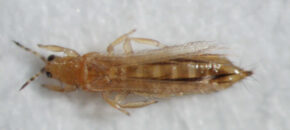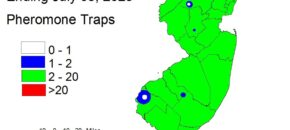Botrytis, or gray mold, caused by the fungus, Botrytis cinerea, can cause significant losses in high tunnel and greenhouse tomato production if not controlled properly. The pathogen can rapidly spread during periods when structures are closed and when relative humidity remains high for long periods of time. This often occurs when outside weather remains cool […]
Continue reading...Identifying and controlling Botrytis in high tunnel and greenhouse tomato production
Monitor for Thrips in Vegetable Crops

Now that spring grains like wheat and rye have dried down and are being combined, thrips in those fields will move to vegetable crops, especially when small grains are adjacent to vegetable fields. Thrips are very small and often missed if casually looking at a plant since they hide in blossoms, under sepals, on under […]
Continue reading...Identifying and controlling leaf mold in high tunnel & greenhouse tomato production
Leaf mold occasionally appears in high tunnel or greenhouse tomato production in New Jersey. However, under ideal conditions the disease will develop in field-grown crops. The fungus will cause infection under prolonged periods leaf wetness and when relative humidity remains above 85%. If relative humidity is below 85% the disease will not occur. Therefore, the […]
Continue reading...Summer Weeds
It finally feels like summer in New Jersey. Rain, humidity, and warmer temperatures, especially at night, mean that warm-season weeds are growing quickly. Of particular concern are summer annuals like crabgrass, goosegrass, and spurges. Yellow nutsedge… Read More »
Continue reading...Controlling basil downy mildew in the field in 2023
For over a decade, basil downy mildew (BDM) has caused significant losses in basil grown in organic and conventional field and greenhouse production across the United States. At the time of its introduction, there were very few fungicides labeled for its control making it nearly impossible to grow a successful crop in many areas of […]
Continue reading...Vegetable IPM Update 7/05/23

Sweet Corn European corn borer (ECB) moth activity is extremely low in areas where blacklight traps are operating in the northern and central counties. Feeding in whorl and pre-tassel stage corn has increased slightly over the past week, but only in a few areas. Many plantings exhibiting no ECB injury at all. While ECB […]
Continue reading...